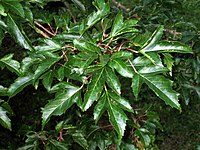
Photo from wikipedia
Acer ginnala Maxim. (Amur maple) is a growing threat to woodland systems in North America. Despite this, Amur maple has been largely ignored by ecologists, and scientific understanding of the… Click to show full abstract
Acer ginnala Maxim. (Amur maple) is a growing threat to woodland systems in North America. Despite this, Amur maple has been largely ignored by ecologists, and scientific understanding of the species is mostly limited to anecdotal evidence from land managers. We evaluated the cover and richness of native and exotic understory plant communities under Amur maple canopies, native tree canopies, and nearby open areas near St. Paul, Minnesota, USA. Overall, Amur maple created dense canopies that only allowed 2% canopy light penetration, strongly reducing cover of all plants except Amur maple. With this critical first step in understanding the impacts of Amur maple complete, we suggest key research priorities related to the distribution of Amur maple, its mechanisms and impacts of invasion, and how best to control its spread in order to encourage future research into Amur maple and mitigate the species’ potential for ecological and economic harm.
Journal Title: Biological Invasions
Year Published: 2018
Link to full text (if available)
Share on Social Media: Sign Up to like & get
recommendations!